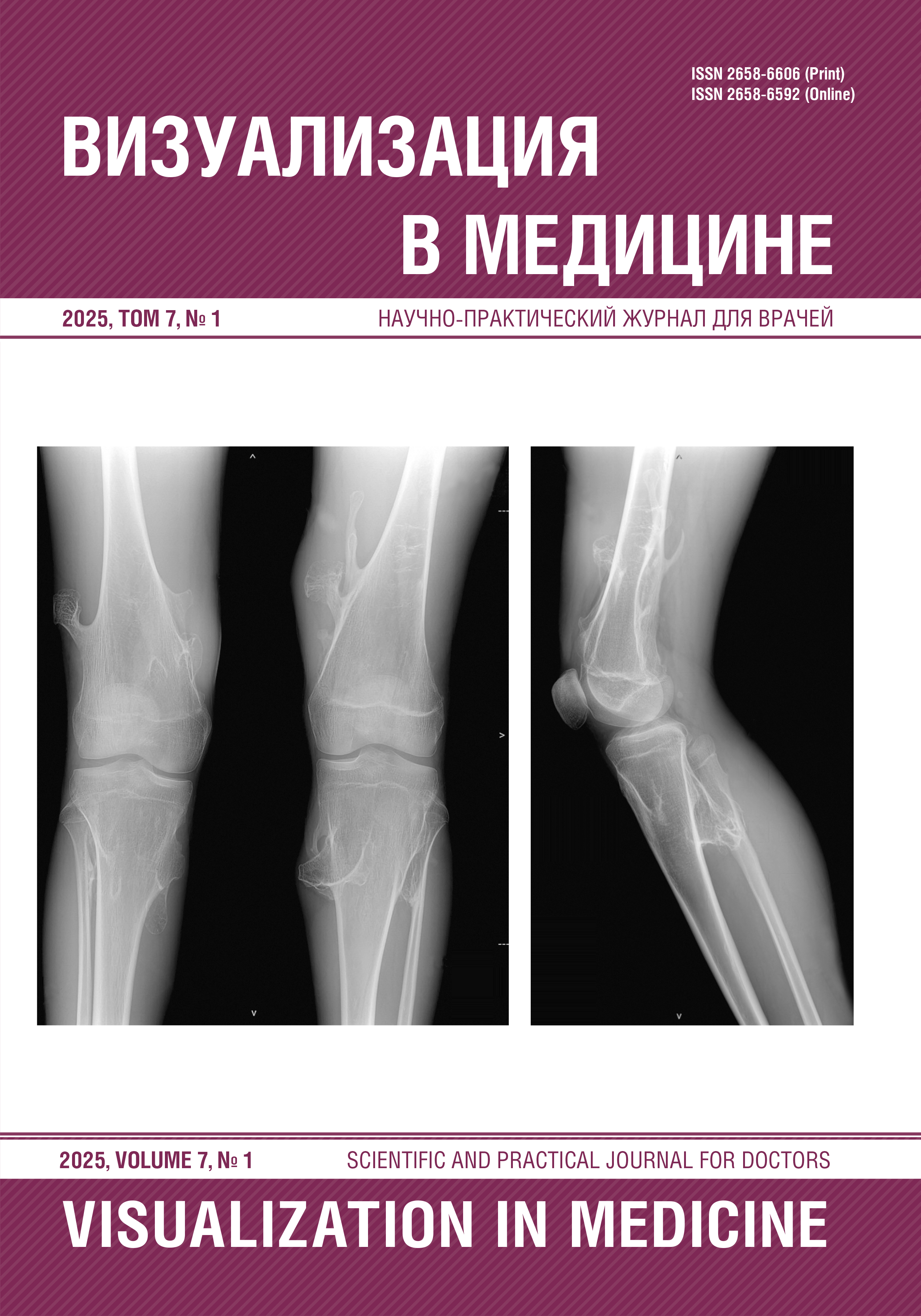THE USE AND SAFETY OF CONTRAST AGENTS IN MODERN IMAGING IN PEDIATRICS
Abstract
Contrast agents (CAs) have become essential tools in medical imaging, enhancing the clarity of anatomical details and the accuracy of result interpretation in X-ray, computed tomography (CT), magnetic resonance imaging (MRI), and ultrasound (US). Despite extensive guidelines for their use in adults, pediatric protocols remain underdeveloped. This creates a gap in clinical practice, given children’s distinct anatomical and physiological features, including metabolic rate, radiation sensitivity, and dosing nuances. This review analyzes approaches to using contrast agents across three key modalities — CT, MRI, and US — in patients ranging from infancy to adolescence. For CT, the focus is on reducing doses of iodine-based agents to minimize risks of nephrotoxicity and allergic reactions. In MRI, gadolinium-based agents are discussed, including their safety in the context of an immature blood-brain barrier and limitations in renal insufficiency. For ultrasound, microbubble agents are examined, which improve vascular and parenchymal organ visualization but require caution in younger children. Special emphasis is placed on protocol adaptations: adjusting contrast volume based on body weight, selecting less invasive techniques, and prioritizing patient psychological comfort. The need for unified pediatric guidelines, grounded in multidisciplinary consensus, is highlighted to optimize diagnostic value while minimizing potential complications.
References
Maloney E., Iyer R.S., Phillips G.S., Menon S., Lee J.J., Callahan M.J. Practical administration of intravenous contrast media in children: screening, prophylaxis, administration and treatment of adverse reactions. 2019;49(4):433–447. DOI: 10.1007/s00247-018-4306-6.
Mammas I.N., Spandidos D.A. The perspectives and the challenges of paediatric radiology: an interview with Dr Georgia Papaioannou, Head of the Paediatric Radiology Department at the ‘Mitera’ Children’s Hospital in Athens, Greece. Exp Ther Med. 2019.18:3238–3242.
Гомболевский В.А, Лайпан А.Ш., Бадюл М.И., Инджиев А.А, Буренчев Д.В., Шапиев А.Н., Ким С.Ю., Подтетенев Д.С., Чернина В.Ю., Морозов С.П., Нуднов Н.В., Проценко Д.Н. Особенности применения контрастных препаратов в лучевой диагностике. Методические рекомендации. М.; 2019.
Callahan M.J., Servaes S., Lee E.Y. et al. Practice patterns for the use of iodinated i.v. contrast media for pediatric CT studies: a survey of the Society for Pediatric Radiology. AJR Am J Roentgenol. 2014;202:872–879.
Clinical applications, safety profiles, and future developments of contrast agents in modern radiology: A comprehensive review. Reabal Najjar. 2024. DOI: 10.1002/ird3.95.
Cheeney S.H.E., Maloney E., Iyer R.S. Safety considerations related to intravenous contrast agents in pediatric imaging. 2023. DOI: 10.1007/s00247-022-05470-z.
McDonald R.J., Weinreb J.C., Davenport M.S. Symptoms associated with gadolinium exposure (SAGE): a suggested term. Radiology. 2021;302:270–273.
Алиханов А.А., Шимановский Н.Л. Применение магнитно-резонансных контрастных средств в детской практике. 2016;1(7):82–94. DOI: 616-053.2-073.756.8.
Andreucci M., Solomon R., Tasanarong A. Side effects of radiographic contrast media: pathogenesis, risk factors, and prevention. BioMed Res Int. 2014;2014:741018–20. DOI: 10.1155/2014/741018.
Zaccarini D.J., Lubin D., Sanyal S., Abraham J.L. Barium sulfate deposition in the gastrointestinal tract: review of theliterature. Diagn Pathol. 2022;17(1):99. DOI: 10.1186/s13000‐022‐01283‐8.
Макаров Л., Поздняков А., Позднякова О. Визуализация образа структур головного мозга. Визуализация в медицине. 2023;5(3):10–15.
Шабалов Н.П., Иванов Д.О., Цыбулькин Э.К. и др. Неонатология. Том 2. М.: МЕДпресс-информ; 2004. EDN: QLGBMN.
Подкаменев А.В., Караваева С.А., Мызникова И.В., Сырцова А.Р., Ти Р.А., Позднякова О.Ф., Кондратьев Г.В., Купатадзе Д.Д., Ли А.Г., Назарова И.В. Кровоизлияние в тимус, имитирующее объемное образование переднего средостения, как осложнение поздней геморрагической болезни у новорожденного. Педиатр. 2018;9(5):120–124. DOI: 10.17816/PED95120-124.
McCulloch M., Gresser C., Moos S., Odabashian J., Jasper S., Bednarz J. et al. Ultrasound contrast physics: a series on contrast echocardiography, article 3. J Am Soc Echocardiogr. 2000;13(10):959–67. DOI: 10.1067/mje.2000.107004.
Ntoulia A., Anupindi S.A., Back SJ et al. Contrast-enhanced ultrasound: a comprehensive review of safety in children. Pediatr Radiol. 2021;51:2161–2180.
Синицын В.Е., Тюрин И.Е., Шимановский Н.Л., Кармазановский Г.Г., Быченко В.Г., Рубцова Н.А., Филатова Д.А. Безопасное использование контрастных средств в рентгенологии (методическое руководство Российского общества рентгенологов и радиологов). Вестник рентгенологии и радиологии. 2023;104(6):363–384. DOI: 10.20862/0042-4676-2023-104-6-363-384.
Dillman J.R., Ellis J.H., Cohan R.H. et al. Allergic-like breakthrough reactions to gadolinium contrast agents after corticosteroid and antihistamine premedication. AJR Am J Roentgenol. 2008;190:187–190.
Amaral J.G., Traubici J., BenDavid G. et al. Safety of power injector use in children as measured by incidence of extravasation. AJR Am J Roentgenol. 2006;187:580–583.
Синицын В.Е., Филатова Д.А., Мершина Е.А. Контраст-индуцированное острое почечное повреждение: современное состояние вопроса. Медицинская визуализация. 2022;26(1):27–39. DOI: 10.24835/1607-0763-1088.
Крылова А.И., Сотникова Е.А., Гольбиц А.Б. Лучевые исследования с контрастным усилением у детей. Педиатр. 2016;7(1):111–119. DOI: 10.17816/PED71111-119.
Kibrom B.T., Manyazewal T., Demma B.D., Feleke T.H., Kabtimer A.S., Ayele N.D., Korsa E.W., Hailu S.S. Emerging technologies in pediatric radiology: current developments and future prospects. Pediatric Radiology. 2023;53:1352–1363. DOI: 10.1007/s00247-022-05470-z.



